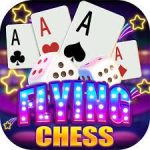Flying Chess Game Official Apk Download V1.6290(0) Pakistan
Description
Flying Chess originated in China in the 1980s, inspired by the traditional Indian game Pachisi and its Western adaptation Ludo. While it shares similarities with these games—like rolling dice, moving tokens around a board, and capturing opponents’ pieces—it introduces unique mechanics, such as shortcut routes and “flying” planes.
The game quickly gained popularity for its easy-to-learn rules and vibrant, airplane-themed board. Today, Flying Chess remains a staple in many Asian households and schools, often played during festivals, family gatherings, or leisure time.
Components of the Game
A standard Flying Chess game includes:
- A board divided into four color-coded zones: red, blue, yellow, and green.
- Four sets of airplane tokens (usually shaped like planes), one set per color, with four tokens in each.
- A single die (or sometimes two dice in some variations).
- Designated launch pads, runways, and home bases for each player.
Each player controls a fleet of four airplanes and aims to fly them from the starting base, around the board, and into the center “home” zone.
Objective of the Game
The objective of Flying Chess is straightforward: be the first player to successfully navigate all four of your airplanes from the starting base to the center of the board, known as the “terminal” or “home.”also there are a good game . lucky 97
However, reaching home isn’t easy. Players must overcome various challenges, including random dice rolls, strategic positioning, and the risk of being knocked back to base by opponents.
Rules of the Game
While different versions of Flying Chess exist, the basic rules are as follows:
1. Getting Started
- Each player picks a color and takes the corresponding four airplanes.
- All airplanes start in the player’s hangar (the starting base).
- Players take turns rolling the die.
2. Launching a Plane
- A player must roll a 6 to move an airplane from the hangar to the starting point on the board (called the launch pad).
- If a player rolls a 6, they get an extra turn.
3. Moving Around the Board
- Once an airplane is on the board, it moves clockwise based on the number rolled.
- If the airplane lands on a space already occupied by an opponent’s plane, the opponent’s piece is sent back to their hangar.
4. Shortcut “Flying” Routes
- Certain colored spaces (matching the player’s color) act as launch pads that allow the airplane to “fly” ahead a fixed number of spaces—often 4, 8, or more.
- This adds an element of surprise and strategy.
5. Landing at Home
- Once an airplane has completed a full lap, it moves into the “home route” and then into the final center space.
- To enter the final center, the player must roll the exact number of spaces required.
6. Winning the Game
- The first player to get all four airplanes into the home base wins.
Strategy and Tactics
While Flying Chess is heavily influenced by luck due to dice rolls, strategic decisions still play a big role in gameplay. Here are a few tactics experienced players use:
1. Selective Deployment
Deciding whether to launch a new airplane or move an existing one is crucial. Launching gives you more presence on the board, but moving forward might help avoid getting sent back.
2. Blocking and Targeting
Positioning airplanes to land on or near opponents can be used offensively. Likewise, avoiding landing on risky spots can help you stay in the game longer.
3. Using Shortcuts
Flying routes can offer significant advantages. A well-timed use of a shortcut can bring an airplane close to home quickly.
4. Staggered Movement
Having airplanes at various stages around the board spreads the risk. This avoids having all pieces sent back at once and increases the chance of at least one finishing the course.
Variations and House Rules
Like many traditional games, Flying Chess has spawned numerous local variations and house rules. Some common ones include:
- Double Dice Version: Players use two dice, increasing movement variability and excitement.
- Bomb Rule: If a player lands on their own plane, they form a “bomb,” and both planes fly together until separated by rules.
- Safe Zones: Some versions introduce safe zones where planes cannot be attacked.
These variations keep the game fresh and allow players to customize the experience according to age and skill level.
Cultural Significance
Flying Chess is more than just a game—it’s a shared cultural experience. In countries like China, it’s often one of the first board games children learn. It promotes family bonding, sportsmanship, and logical thinking from a young age. The airplane theme adds a sense of adventure and imagination, making it especially appealing to children.
The game also finds its place in schools and therapy settings, where it’s used to teach patience, turn-taking, and basic math through dice rolls and counting spaces.
Digital Adaptations
With the rise of mobile gaming, Flying Chess has been adapted into numerous digital formats. Apps available on Android and iOS offer online multiplayer, AI opponents, and even 3D versions with animations and sound effects. These digital versions help preserve the game’s legacy while introducing it to newer generations accustomed to screens over boards.
Conclusion
Flying Chess is a perfect example of how a simple board game can offer endless entertainment and life lessons. It blends luck, strategy, and interaction in a way that appeals to both kids and adults. Whether played on a physical board during a family game night or on a smartphone app during a bus ride, Flying Chess continues to bring people together through fun, friendly competition.
With its colorful design and accessible gameplay, it’s no surprise that Flying Chess has flown high in the hearts of players for decades—and will likely continue to soar for many more to come.
